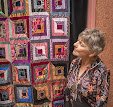

I recently bought this double-bed-sized Frame Quilt from a Cockermouth dealer. I think the centre is quite unusual, being a Hawaiian-style appliqué cut from a single piece of fabric. In all other respects, this is a classic English Frame Quilt, with nine borders, some of which are pieced, surrounding the centre square. It is quilted with the characteristic All-over Wave pattern found in the regions bordering the Irish Sea. The fabrics are all dress cottons and look, at first sight and without researching any of them, as if they date from the mid-C19th.
The condition of the quilt is fair, with considerable fading on one end. There are a few small holes where the fabric has worn through to reveal the cotton wadding.
The dealer told me that the quilt had been brought to her by a local lady, who said it had belonged to her mother. Of course, the dealer was unwilling to give me the name of the person from whom she'd bought it - I can only assume because she didn't want me to know how much she'd paid for it. (Or am I being cynical?!)
I'm thinking of advertising locally to see if I can find the seller, from whom I might be able to get some provenance.
The quilt is a useful and interesting addition to my small collection of local (i.e. West Coast) quilts since this is the first example of this particular style I've been able to acquire. I'd be interested to hear from anyone who has knowledge of any other Frame Quilts with appliqué centres.

 One of my p&q pupils has a friend in Ontario, who sent her this table runner. It's actually very simply constructed, using Drunkard's Path blocks in an imaginitive way to produce a very strking design.
One of my p&q pupils has a friend in Ontario, who sent her this table runner. It's actually very simply constructed, using Drunkard's Path blocks in an imaginitive way to produce a very strking design.








